Visions from the Other Side is a freeware Japanese visual novel which was first released in Japan for Windows as Mukou no Yume in February 2002. It was officially translated into English for the 2006 al|together festival and made available for Windows, Linux, and MacOS on August 19, 2006. Below, I will review Visions from the Other Side as part of my ongoing project to review nearly all of the 30 freeware visual novels that were translated as part of the 2005, 2006, and 2008 al|together festivals.

You can learn more about my al|together project by reading my project introduction article. That article includes a running list of our completed al|together reviews. I have a dedicated collection post with links to all of our al|together articles, including reviews, essays, and short posts.
Visions from the Other Side’s principal protagonist and view-point character is a miko (shrine maiden) who commits suicide and returns to the world as a ghost. In the short story, which takes somewhere in the neighborhood of 15-20 minutes to read, we also view the world from the perspective of two other characters.
Visions from the Other Side Details
English Release
| Title | Visions from the Other Side |
| Translator | Edward Keyes |
| Release Date | August 19, 2006 |
| Engine | ONScripter |
| Official Website | altogether 2006; Insani |
| Visual Novel Database | VNDB Link |
Japanese Release
| Title | Mukou no Yume |
| Developer | Treasures |
| Release Date | February 2003 |
| Engine | NScripter |
Downloading and Running Visions from the Other Side
Visions from the Other Side is still available via direct download for Windows, MacOS, and Linux. Torrent downloads are also available from Insani.
- Official (Direct and Torrent): Windows, Linux, and MacOS
- Insani (Torrent): Windows, Linux, and MacOS
- Kaisernet Mirror (Windows direct only): Windows
I ran Visions from the Other Side on both Linux and Windows (on top of WINE). For those interested in running it natively on Linux, I have written guides for installing ONScripter-EN, running ONScripter-EN in a game directory, and extracting the contents of an ONScripter-EN .exe to run the game natively on Linux. I have not personally tested the MacOS version of Visions nor have I tried running it on BSD, but my understanding is that it should work on both systems provided the user follows the ONScripter-EN documentation.
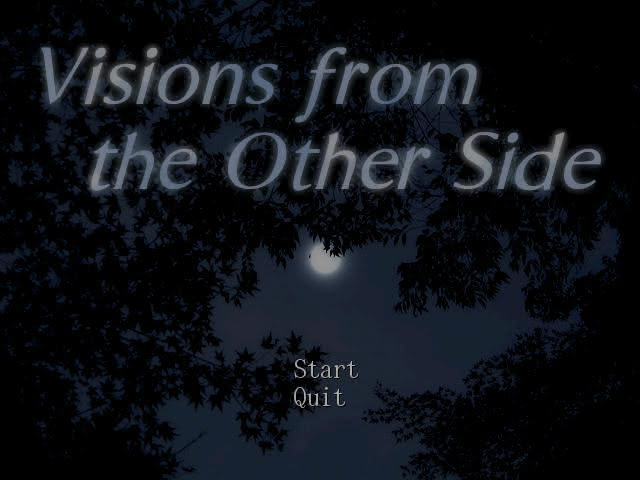
Despite the fact that I can run Visions from the Other Side natively on Linux, my review is based on the Windows version running on top of WINE. 11/27/23 Update: Visions uses MIDI for its background music. At the time I reviewed it, I was having difficulty getting the music to play when running it natively on Linux. I opted to run the Windows version with WINE since everything worked there with no issue. I subsequently resolved the MIDI issue for native Linux ONScripter-EN games on my system. I confirmed that everything works with a proper MIDI set up and the 2011 Linux ONScripter-EN build. As of November 27, 2023, I did not have luck with sound using the more recent ONScripter-EN builds (see GitHub issue).
(Note that the sound effects in Visions are .wav files instead of MIDI files.)
General Overview of Visions from the Other Side
The official Insani website page for Visions from the Other Side describes the game as follows:
Here a dream, there a dream, and the shades of an other world that spreads beyond the gate of death. Where will you go? Where will your disembodied feet lead you?
… may the road come up to meet you and may you never tread on cantankerous fish.
This description is cryptic, but so too is Visions from the Other Side. The synopsis makes the story sound a bit more dramatic than it actually is, but it is accurate enough. Interestingly, the most clear line – “may you never tread on cantankerous fish” – turns out to be a very accurate description of an event in Visions.
It is not my intention to spoil Visions for those who may be interested in reading it. In light of the fact that it takes only 15-20 minutes to read, limit my ability to describe it without spoiling it. The game begins with a shrine maiden, Chisato, who appears to be on the verge of jumping off a cliff.
We are led to believe that she jumps, and the next scene has her waking up in the same world as a ghost. Chisato learns the rules of her new ghostly existence and, as the Insani synopsis suggests, steps on a cantankerous fish. We later meet a couple of other characters, including Chisato’s younger sister, Chiyo.
Visions from the Other Side Review
I will review the different components of Visions from the Other Side in the following sub-sections.
Game-play and structure
Visions from the Other Side is an entirely linear visual novel with no choices or player input other than advancing the text.
Visual presentation
Visions from the Other Side is unmistakably an early-2000s NScripter visual novel (the English version is written in ONScripter-EN), but it nevertheless looks good by the standards of the al|together collection.
Like many NScripter/ONScripter projects, the text runs from the top of the screen to the bottom, overlaying both the background and any character portraits. Other than noting that the lack of contrast between the thin font , and the backgrounds may be difficult for some people to read (I did not personally have an issue), there is nothing unusual about the manner of displaying text.
Most of the backgrounds appear to be based on photographs with some artistic flourishes, although a few are reminiscent of the painted backgrounds which we saw in games like The Poor Little Bird and Wanderers in the Sky.
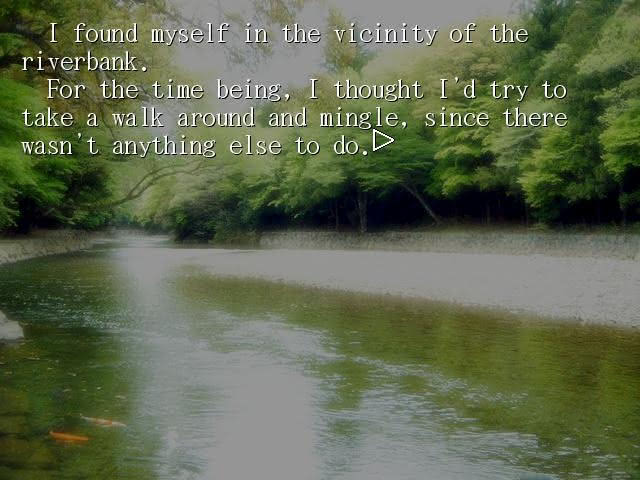
These backgrounds are attractive by the standards of the al|together projects, although the backgrounds for scenes that are described as including people feel a little bit lifeless.
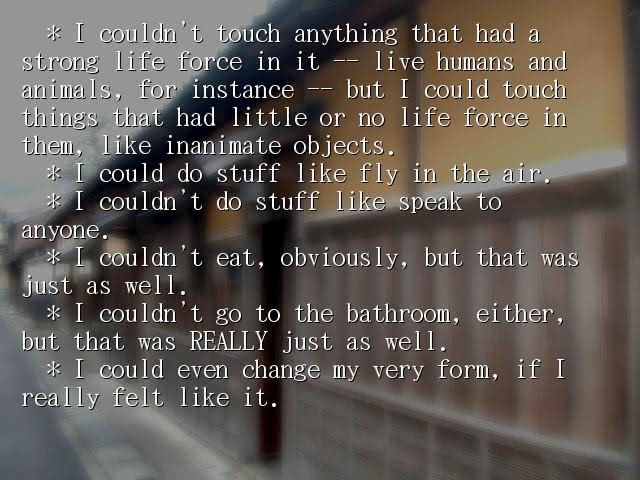
Three characters in Visions have full character portraits, although despite the fact that the entire story is narrated, the character portraits do not make an appearance until close to the half-way point. Chisato’s (the principal protagonist) portrait is generic, distinguished only by her miko robes (see our May Sky review for another visual novel featuring a shrine maiden), but it looks decent on the whole. The two other characters with portraits, one of whom is Chisato’s younger sister, Chiyo, have more memorable appearances, albeit still generic in design.

The most interesting visual element of Visions is that it has five CG scenes, meaning fully drawn scenes interspersed among the ordinary backgrounds. This is a good amount of CG scenes for what is ultimately a very short visual novel. Each scene features a character, and the designs are consistent with the character portraits, but unsurprisingly more detailed and vivid.
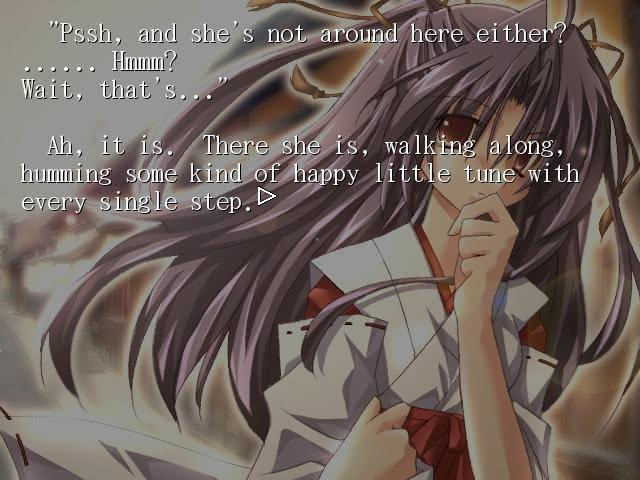
Completing the story unlocks a CG Gallery on the main menu.
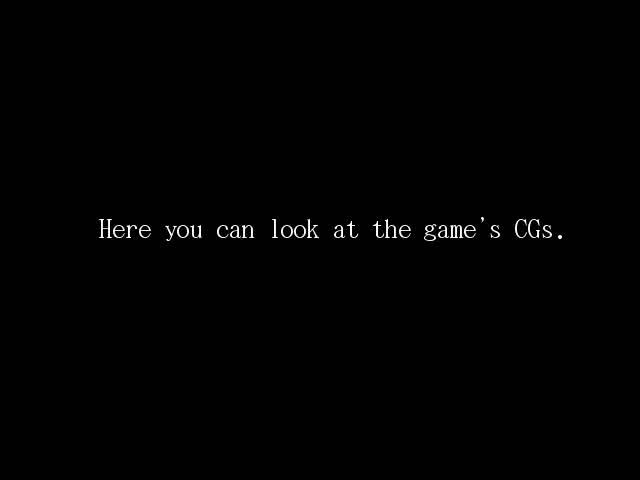
The first scene of the game includes some interesting textual backgrounds with lines from Chisato as she proceeds to the edge of a cliff and her death.
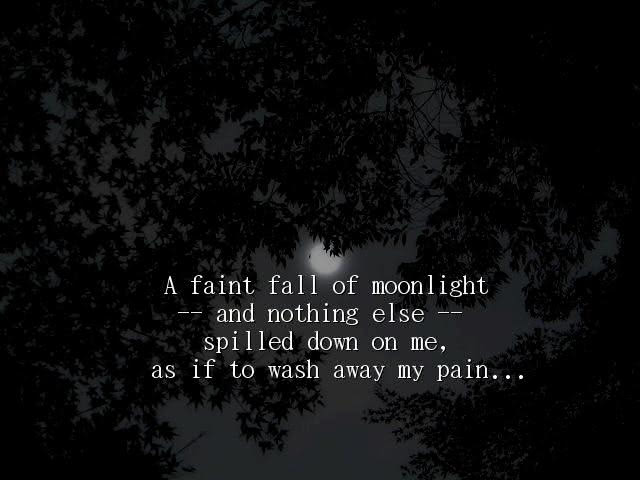
In a final note, I liked how well the credits are done – mixing the names of the people behind the original Japanese game and the English translation next to washed-out versions of the story’s backgrounds.
Similarly to The Poor Little Bird, all of the game’s background and art, which consists of .jpg files, is available in the game’s data folder/directory without any additional steps. In the event you are planning to read the game, I recommend saving the directory for when you are done (and do not move or re-name files for obvious reasons).
Music
Having noted Visions’s MIDI dependency for music, it has one of the better musical scores of the al|together projects I have reviewed thus far. It uses synthetic piano tracks mixed with other background melodies and effects – the overall effect is haunting, mysterious, and in line with the mood of the story.
Visions also features sound effects, including those for cicadas and waves. The sound effects are good, but too loud (perhaps to overpower the music). In theory, the volume can be configured in the game’s 0.txt file for those who are somewhat familiar with ONScripter and its derivatives, but the game is short enough that the best solution is to mind the volume during the first couple of scenes.
Translation quality
I append my analysis of the translation to explain that I am only reviewing how the game reads in English. I have never played the original Japanese version of Wanderers in the Sky, and even if I had, I cannot read Japanese. Thus, I can only review the translation from an English-speaking reader’s perspective.
Despite its short length, I imagine that Visions, which is a bit mysterious and leaves many questions unanswered, was not the easiest story to translate. However, the translation was done by the excellent team at Insani, with Mr. Edward Keyes serving as the principal translator under the supervision of Mr. Seung Park, and – to the surprise of no one familiar with their other work – it reads quite well in English. Visions makes unusually frequent use of caps lock for emphasis (compared to other reviews), but it chooses those spots wisely.
The only point of difficulty I had was that there are a few scene transitions where it is not immediately obvious who is narrating in the new scene. However, in context, I will venture this issue was inherited from the original rather than being a product of the translation.
11/27/23 Update: I recommend reading short essays by Mr. Keyes and Mr. Park on some of the unexpected difficulties that emerged during the translation process and how they worked through them to produce a very readable final product. Insani made these essays available anew after coming out of a lengthy retirement.
Writing and story quality
Visions from the Other Side is a strange duck in the al|together collection.
While Chisato is the first and most prominent narrator, the story jumps around, at different points inviting four characters in total to narrate different sections. We seem to begin the game a good while in the past before it concludes, with a twist at the end, in a different time.
On one hand, Visions is surprisingly tightly-written. If a character says or describes something specific, you will find that there is a story-related reason that the character does so. On the other hand, Visions is reluctant to show its hand, leaving many loose threads and unanswered questions. For example, we know for a fact that Chisato did end her life by jumping off a cliff, but she never addresses the precise reason why she did so (one could venture some guesses, but is ultimately speculation). What of Chiyo’s experiments? The nature of the fish? The mother of Chisato and Chiyo? All unclear.
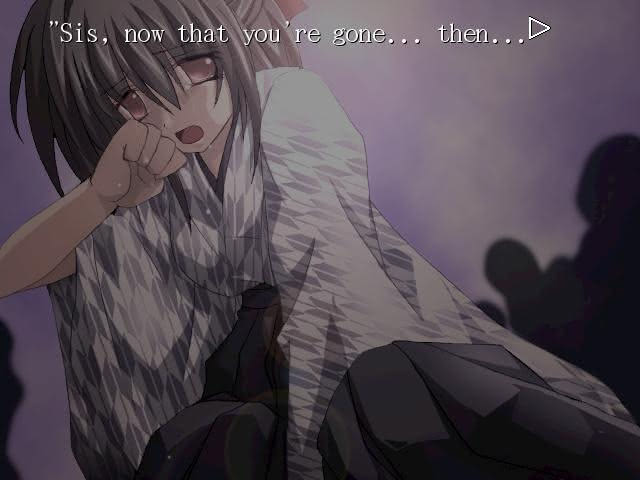
It is entirely possible that there are some intended references that I am not privy to, but I suspect that most readers will find themselves with many more questions than answers upon finishing the story. One could describe Visions charitably as an experimental piece.
One may recall that in my review and analysis of Shooting Star Hill (a quite different visual novel from the same project), I noted one potential critique – that the story included supernatural/alien elements but did not fully explain them. However, I explained in my analysis that these aspects had a clear and distinct purpose in the story of a lonely girl and the boy who was invested in saving her from loneliness. Visions, like Shooting Star Hill, introduces supernatural elements (namely ghosts) without fully explaining them. Unlike Shooting Star Hill, however, I came away lacking a clear idea of what the point of the story was.
Having noted some difficulties I had with Visions, it does have strong points. Chisato makes for an entertaining narrator – especially in her early attempts to figure out the rules of being a ghost and her later interactions with a certain aquatic creature. Each scene in isolation, notwithstanding the ultimate lack of answers, is reasonably entertaining . Moreover, I did appreciate that to the extent Visions does provide explanations, they are conveyed it is with an economical with its use of words and events.
Final Assessment
Visions from the Other Side was interesting to read through once, but its failure to explain things that to me would be integral to the story or to have an obvious purpose or message renders it more of a historical curiosity than a strong story in and of itself. At best, I would give it a qualified recommendation for people who are already trying al|together visual novels based on its strong aesthetics (CG art, music), its short run time, and the fact that it is easy to obtain and run (save for some potential MIDI-related challenges).
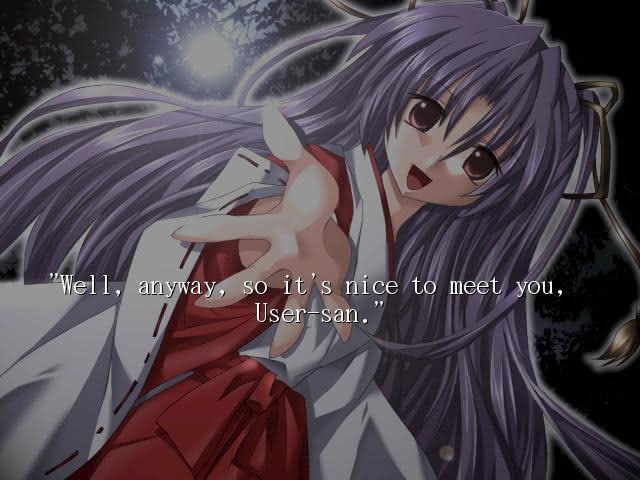
I would recommend Visions more easily to those who are interested in older visual novels or, specifically, indie works from Japan. In this case, its art and music are interesting for an older NScripter piece, and while its experiments were hit and miss, it made a genuine effort to try and execute some interesting ideas in the context of a short, linear story.